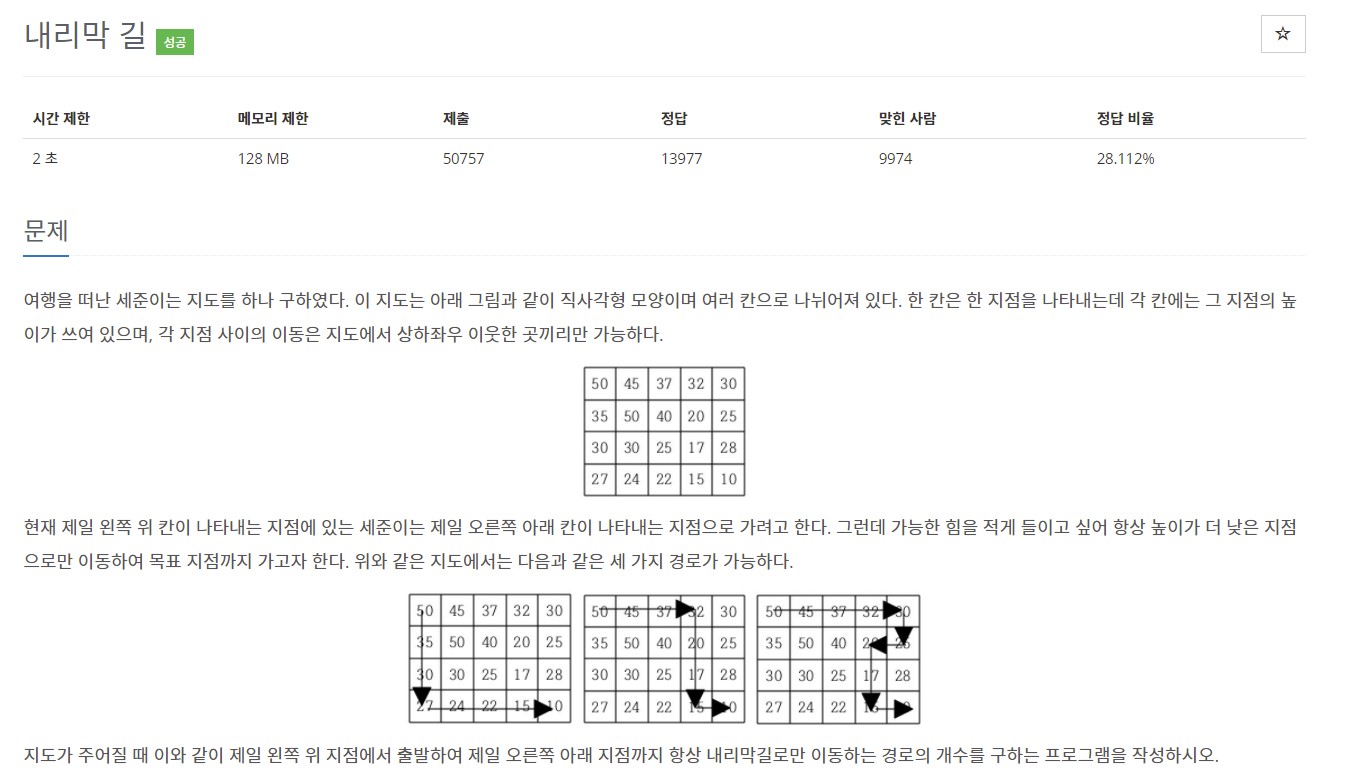✏️2. DFS
- 먼저 dp를 사용하지 않은 완전 탐색 알고리즘을 살펴보자
int cnt = 0;
void dfs1(int y, int x) {
if (y == M - 1 && x == N - 1) cnt++;
for (int dir = 0; dir < 4; dir++) {
int ny = y + dy[dir];
int nx = x + dx[dir];
if (ny < 0 || nx < 0 || ny >= M || nx >= N) continue;
if (map[y][x] > map[ny][nx])
dfs1(ny, nx);
}
}
(y,x)가 (M-1, N-1)에 도달했을 경우 카운트 해준다- 현재 위치
(y,x)를 기준으로 네 방향으로 탐색해서 다음 방향이 현재 자신의 크기보다 작다면 (내리막길이라면) 다시 그 다음지점에서 dfs 탐색을 반복한다
- 이미 탐색했던 곳을 중복해서 탐색하게 된다
int dfs2(int y, int x) {
if (y == M - 1 && x == N - 1) return 1;
if (dp[y][x] != -1) return dp[y][x];
dp[y][x] = 0;
for (int dir = 0; dir < 4; dir++) {
int ny = y + dy[dir];
int nx = x + dx[dir];
if (ny < 0 || nx < 0 || ny >= M || nx >= N) continue;
if (map[y][x] > map[ny][nx])
dp[y][x] += dfs2(ny, nx);
}
return dp[y][x];
}
(y,x)가 (M-1, N-1)에 도달했을 경우 1가지 경우를 더해준다dp[y][x]!=-1 이라는 뜻은 이미 (y,x)지점에서 (M-1, N-1)까지 가는 탐색을 했다는 뜻이고 그 경우는 총 dp[y][x]가지라는 뜻이다- 탐색을 시작한다는 의미로
dp[y][x]=0로 만들어준다
dp[y][x]+=dfs2(ny,nx) : bottom-up 방식으로 (M-1, N-1)에서 가장 가까운 위치부터 탐색한다
🔖Source Code
#include <iostream>
#include <vector>
#include <string.h>
using namespace std;
const int MAX = 501;
int M, N;
vector<vector<int>>map;
int dp[MAX][MAX];
int dy[] = { 0,0,1,-1 };
int dx[] = { 1,-1,0,0 };
int dfs2(int y, int x) {
if (y == M - 1 && x == N - 1) return 1;
if (dp[y][x] != -1) return dp[y][x];
dp[y][x] = 0;
for (int dir = 0; dir < 4; dir++) {
int ny = y + dy[dir];
int nx = x + dx[dir];
if (ny < 0 || nx < 0 || ny >= M || nx >= N) continue;
if (map[y][x] > map[ny][nx])
dp[y][x] += dfs2(ny, nx);
}
return dp[y][x];
}
int cnt = 0;
void dfs1(int y, int x) {
if (y == M - 1 && x == N - 1) cnt++;
for (int dir = 0; dir < 4; dir++) {
int ny = y + dy[dir];
int nx = x + dx[dir];
if (ny < 0 || nx < 0 || ny >= M || nx >= N) continue;
if (map[y][x] > map[ny][nx])
dfs1(ny, nx);
}
}
void input() {
memset(dp, -1, sizeof(dp));
cin >> M >> N;
map = vector<vector<int>>(M, vector<int>(N));
for (int i = 0; i < M; i++)
for (int j = 0; j < N; j++)
cin >> map[i][j];
}
int main() {
input();
//dfs1(0, 0);
//cout << cnt << endl;
cout<<dfs2(0, 0)<<endl;
return 0;
}



